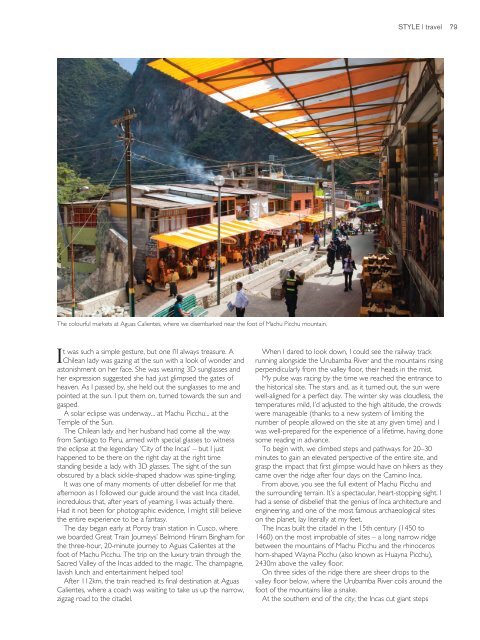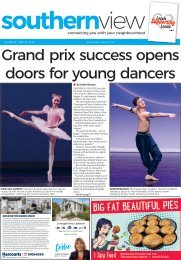You also want an ePaper? Increase the reach of your titles
YUMPU automatically turns print PDFs into web optimized ePapers that Google loves.
STYLE | travel 79<br />
The colourful markets at Aguas Calientes, where we disembarked near the foot of Machu Picchu mountain.<br />
It was such a simple gesture, but one I’ll always treasure. A<br />
Chilean lady was gazing at the sun with a look of wonder and<br />
astonishment on her face. She was wearing 3D sunglasses and<br />
her expression suggested she had just glimpsed the gates of<br />
heaven. As I passed by, she held out the sunglasses to me and<br />
pointed at the sun. I put them on, turned towards the sun and<br />
gasped.<br />
A solar eclipse was underway... at Machu Picchu... at the<br />
Temple of the Sun.<br />
The Chilean lady and her husband had come all the way<br />
from Santiago to Peru, armed with special glasses to witness<br />
the eclipse at the legendary ‘City of the Incas’ – but I just<br />
happened to be there on the right day at the right time<br />
standing beside a lady with 3D glasses. The sight of the sun<br />
obscured by a black sickle-shaped shadow was spine-tingling.<br />
It was one of many moments of utter disbelief for me that<br />
afternoon as I followed our guide around the vast Inca citadel,<br />
incredulous that, after years of yearning, I was actually there.<br />
Had it not been for photographic evidence, I might still believe<br />
the entire experience to be a fantasy.<br />
The day began early at Poroy train station in Cusco, where<br />
we boarded Great Train Journeys’ Belmond Hiram Bingham for<br />
the three-hour, 20-minute journey to Aguas Calientes at the<br />
foot of Machu Picchu. The trip on the luxury train through the<br />
Sacred Valley of the Incas added to the magic. The champagne,<br />
lavish lunch and entertainment helped too!<br />
After 112km, the train reached its final destination at Aguas<br />
Calientes, where a coach was waiting to take us up the narrow,<br />
zigzag road to the citadel.<br />
When I dared to look down, I could see the railway track<br />
running alongside the Urubamba River and the mountains rising<br />
perpendicularly from the valley floor, their heads in the mist.<br />
My pulse was racing by the time we reached the entrance to<br />
the historical site. The stars and, as it turned out, the sun were<br />
well-aligned for a perfect day. The winter sky was cloudless, the<br />
temperatures mild, I’d adjusted to the high altitude, the crowds<br />
were manageable (thanks to a new system of limiting the<br />
number of people allowed on the site at any given time) and I<br />
was well-prepared for the experience of a lifetime, having done<br />
some reading in advance.<br />
To begin with, we climbed steps and pathways for 20–30<br />
minutes to gain an elevated perspective of the entire site, and<br />
grasp the impact that first glimpse would have on hikers as they<br />
came over the ridge after four days on the Camino Inca.<br />
From above, you see the full extent of Machu Picchu and<br />
the surrounding terrain. It’s a spectacular, heart-stopping sight. I<br />
had a sense of disbelief that the genius of Inca architecture and<br />
engineering, and one of the most famous archaeological sites<br />
on the planet, lay literally at my feet.<br />
The Incas built the citadel in the 15th century (1450 to<br />
1460) on the most improbable of sites – a long narrow ridge<br />
between the mountains of Machu Picchu and the rhinoceros<br />
horn-shaped Wayna Picchu (also known as Huayna Picchu),<br />
2430m above the valley floor.<br />
On three sides of the ridge there are sheer drops to the<br />
valley floor below, where the Urubamba River coils around the<br />
foot of the mountains like a snake.<br />
At the southern end of the city, the Incas cut giant steps


















